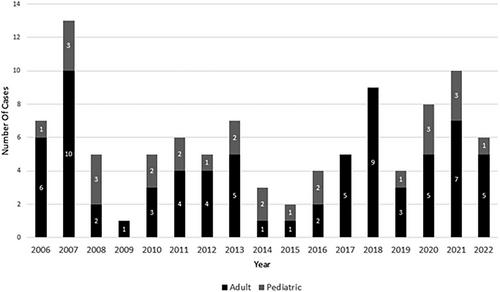Epidemiology and characteristics of coral snake bites reported to the National Poison Data System (2006‒2022)
Abstract
Objectives
North American coral snake envenomations can result in life-threatening neurotoxicity. Their bites are relatively rare, making large studies difficult. Using the National Poison Data System (NPDS), we sought to investigate the epidemiological trends and clinical outcomes associated with North American coral snake bites over a 17-year period.
Methods
NPDS cases involving coral snakes from January 1, 2006, to December 31, 2022, were analyzed. Data collected included patient age, date, geographic location, clinical effects, treatments administered, and medical outcomes including incidence of “dry bites” (non-envenomation) and death.
Results
During the 17-year period, a total of 1374 cases were reported and analyzed. Cases included adults (≥ 20 years), accounting for 80% (n = 1107), and pediatric patients (≤19 years), accounting for 20% (n = 267) of total cases. Out of 50 US states and District of Columbia, 20 states reported cases. Florida and Texas accounted for 90.5% of all bites (n = 1243) with April being the month with the most reported cases (n = 184). The most bites (n = 96) were reported in 2008 and the fewest (n = 69) in 2016. Male patients predominated for both pediatric (75.7%, n = 202) and adult cases (75.3%, n = 834). Moderate to major clinical outcomes were documented in approximately 30% of total cases; with no reported deaths. Moderate effect is defined as the patient exhibited symptoms as a result of the exposure that were more pronounced, more prolonged, or more of a systemic nature than minor symptoms. Major effect was defined as the patient exhibited symptoms as a result of the exposure that were life threatening or resulted in significant residual disability or disfigurement. The three most reported clinical effects were wound/sting, dermal irritation/pain, and edema. Antivenom was administered in 21% (n = 286) of total cases and 37% (n = 511) of patients were admitted to a critical care unit. Dry bites occurred in 7% (n = 100) of total cases.
Conclusion
Coral snake bites were rare, but consistently reported. While bites were associated with significant morbidity in adult and pediatric patients, there were no deaths reported. Antivenom use declined over the study period but was not associated with an increase in morbidity. An increased incidence of intubations was seen in association with decreased antivenom use.


 求助内容:
求助内容: 应助结果提醒方式:
应助结果提醒方式:


